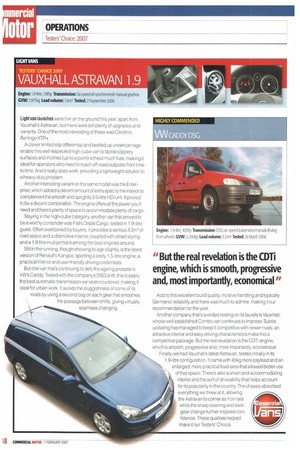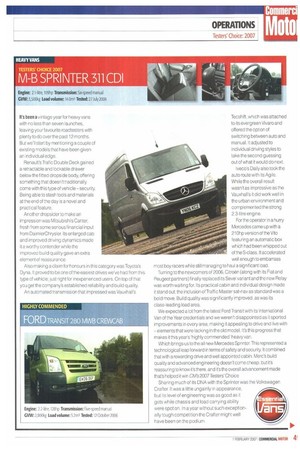ASTRAVAN 1.9
Page 48

Page 49

If you've noticed an error in this article please click here to report it so we can fix it.
Engine: 1.9-litre, 118hp Transmission: Six speed all-synchromesh manual gearbox GVW: 1,975 kg Load volume: I 6rn Tested: 21September 2006
Light van launches were thin on the ground this year, apart from Vauxhall's Astravan, but there were still plenty of upgrades and variants. One of the most interesting of these was Citroen's Berlingo XTR+.
A clever limited slip differential and beefed up undercarriage enable this well respected high-cube van to tackle slippery surfaces and inclines (up to a point) without much fuss, making it ideal for operators who need to reach off-road outposts from time to time. And it really does work, providing a lightweight solution to a heavy-duty problem.
Another interesting variant on the same model was the Enterprise, which added a decent amount of extra spec to the interior to complement the smooth and sprightly 2.0-litre HDi unit. It proved to be a decent combination. The engine offers all the power you'll need and there's plenty of space to accommodate plenty of cargo. Staying in the high-cube category, another van that proved to be a worthy contender was Fiat's DoblO Cargo, tested in 1.9-litre guise. Often overlooked by buyers. it provides a serious 3.2rns of load space and a distinctive interior, coupled with smart styling and a 1.9-litre multijet that's among the best engines around. Still in the running, though showing its age slightly, is the latest version of Renault's Kangoo, sporting a zesty 1 .5-litre engine, a practical interior and user-friendly driving credentials.
But one van that's continuing to defy the ageing process is VW's Caddy. Tested with the company's DSG shift, this is easily the best automatic transmission we've encountered, making it ideal for urban work. It avoids the sluggishness of some of its rivals by using a second cog on each gear that smoothes the passage between shifts, giving virtually seamless changing. Add to this excellent build quality, incisive handling and typically Germanic reliability and there was much to admire, making it our recommendation for the year.
Another company that's avoided resting on its laurels is Vauxhall, whose well established Combo van continues to impress. Subtle updating has managed to keep it competitive with newer rivals; an attractive interior and easy driving characteristics make this a competitive package. But the real revelation is the CDTi engine, which is smooth, progressive and, most importantly, economical.
Finally, we had Vauxhall's latest Astravan, tested initially in its 1.9-litre configuration. It came with 45kg more payload and an enlarged, more practical load area that allowed better use of that space. There's also a smart and accommodating interior and the sort of driveability that helps account far its popularity in this country. The chassis absorbed everything we threw at it, allowing the Astravan to corner as if on rails while the sharp steering and slick gear change further inspired confidence. These qualities helped make it our Testers' Choice. It's been a vintage year for heavy vans with no less than seven launches, leaving your favourite roadtesters with plenty to do over the past 12 months. But we'll start by mentioning a couple of existing models that have been given an individual edge.
Renault's Trafic Double Deck gained a retractable and lockable drawer below the fitted dropside body, offering something that doesn't traditionally come with this type of vehicle— security. Being able to stash tools and materials at the end of the day is a novel and practical feature.
Another dropsider to make an impression was Mitsubishi's Canter, fresh from some serious financial input from DaimlerChrysler. Its enlarged cab and improved driving dynamics made it a worthy contender while the improved build quality gave an extra element of reassurance.
Also making a claim for honours in this category was Toyota's Dyna. It proved to be one of the easiest drives we've had from this type of vehicle; just right for inexperienced users. On top of that you get the company's established reliability and build quality.
An automated transmission that impressed was Vauxhall's Tecshiff, which was attached to its evergreen Vivaro and offered the option of switching between auto and manual. It adjusted to individual driving styles to take the second guessing out of what it would do next.
Iveco's Daily also took the auto route with its Agile. While the overall result wasn't as impressive as the Vauxhall's it did work well in the urban environment and complemented the strong 2.3-litre engine.
For the operator in a hurry Mercedes came up with a 210hp version of the Vito featuring an automatic box which had been whipped out of the S-class. It accelerated well enough to embarrass most boy racers while still managing to haul a significant load.
Turning to the newcomers of 2006, Citroen (along with its Fiat and Peugeot partners) finally replaced its Sevel variant and the new Relay was worth waiting for. Its practical cabin and individual design made it stand out; the inclusion of Traffic Master sat-nay as standard was a bold move. Build quality was significantly improved, as was its class-leading load area.
We expected a lot from the latest Ford Transit with its International Van of the Year credentials and we weren't disappointed as it sported improvements in every area, making it appealing to drive and live with —elements that were lacking in the old model. It's this progress that makes it this year's 'highly commended' heavy van.
Which brings us to the all new Mercedes Sprinter. This represented a technological leap forward in terms of safety and security. It combined that with a rewarding drive and well appointed cabin. Merc's build quality and advanced engineering doesn't come cheap, but it's reassuring to know it's there, and it's the overall advancement made that's helped it win CM's 2007 Testers' Choice
Sharing much of its DNA with the Sprinter was the Volkswagen Crafter. It was a little ungainly in appearance, but its level of engineering was as good as it gets while chassis and load carrying ability were spot on. In a year without such exceptionally tough competition the Crafter might well have been on the podium.


























































































































































































